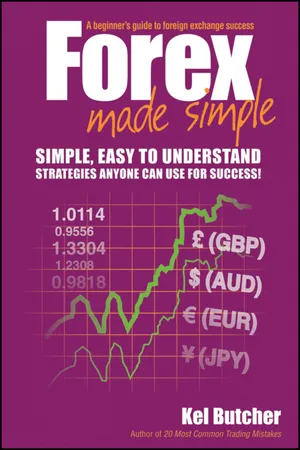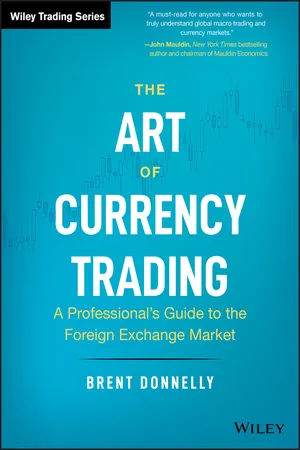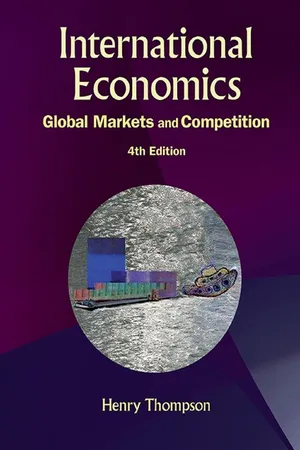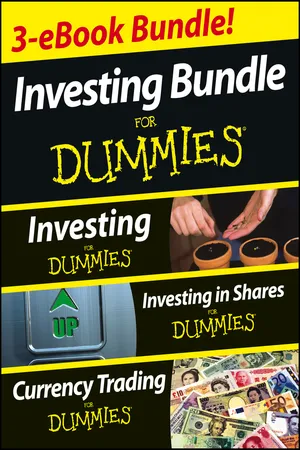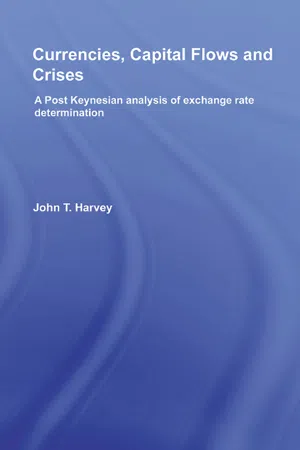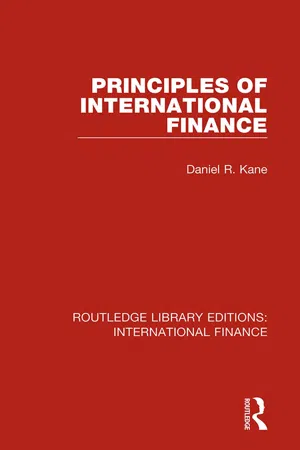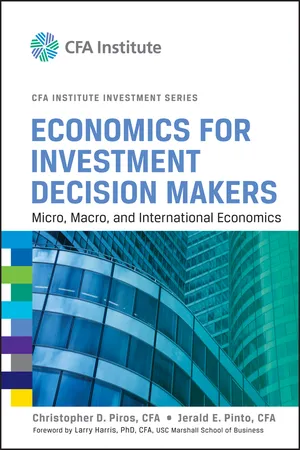Economics
Factors Influencing Foreign Exchange Market
The foreign exchange market is influenced by various factors including interest rates, inflation, government policies, and market speculation. Changes in these factors can impact the supply and demand for different currencies, leading to fluctuations in exchange rates. Additionally, economic indicators, geopolitical events, and market sentiment also play a significant role in shaping the dynamics of the foreign exchange market.
Written by Perlego with AI-assistance
Related key terms
8 Key excerpts on "Factors Influencing Foreign Exchange Market"
- eBook - ePub
FX Trading
A Guide to Trading Foreign Exchange
- Alex Douglas, Larry Lovrencic, Peter Pontikis(Authors)
- 2011(Publication Date)
- Wiley(Publisher)
Chapter 7: Factors influencing FX marketsOver the longer term, it is undeniable that underlying economic fundamentals will drive the currency markets in one direction or the other. In the shorter term, however, elements of fear, greed and herd behaviour drive the foreign exchange markets. This herd mentality can be reflected in short-term movements that are often a reaction to market rumours, or might evolve as a longer term phenomenon because traders are paying undue attention to one area of market influence while virtually ignoring another. We saw this in the late 1990s, when the United States and the USD became the ‘flavour of the month’ among global investors, despite the everpresent trade deficit.Many factors in each country can and do affect the economy of that country and the value of its currency. To make matters worse, it is the interrelationship between these factors that drives the markets. This is complex enough when just looking at one country, but in the currency markets we are looking at how all of these factors interrelate, not just within the borders of each country, but how they interrelate across borders around the world. This makes it extremely difficult to accurately pinpoint exactly which factor is responsible for any particular movement in a market. This is the challenge for the FX trader.Nonetheless, it is worth having a broad understanding of the theoretical way in which various fundamental and economic factors are generally seen to affect the foreign exchange market, and this is what we examine in this chapter.Supply and demandPrices (or exchange rates) are ultimately determined by the relative influence of the forces of supply and demand. If there is very high demand for a particular currency, its value would be expected to increase in relation to currencies that there is less demand for. On the other hand, if there is a desire among holders of a particular currency to dispose of that currency in exchange for another, its value is likely to decline in relation to other currencies. - eBook - ePub
Forex Made Simple
A Beginner's Guide to Foreign Exchange Success
- Kel Butcher(Author)
- 2011(Publication Date)
- Wiley(Publisher)
Chapter 8: Macro economics and how it affects forexTrading forex, with its high levels of liquidity, and the constant ebb and flow of buyers and sellers, is well suited to the use of technical analysis in its various forms. Technical analysis and the many indicators, oscillators, levels, patterns and moving averages, combined with price action, provide a multitude of trading signals for the proficient and effective trader.Perhaps more than in any other market, a huge range of fundamental economic parameters and events affect the forex market. All forex traders need to be aware of the data and economic indicators that impact on currency exchange rates. It is also handy to have a grasp of the underlying strengths and weaknesses of the major global economies, and to have a general understanding of where they are in terms of the broader economic cycle. For each of the most commonly traded currencies, its unique characteristics and specific economic data and events have the most significant impact on their value.Tip There is often a great deal of anticipation and speculation by traders in the lead-up to the release of data on the specified dates.This chapter takes a broad look at some of the economic data, events and indicators that influence currency values, and what happens to currency values when these economic indicators change either unexpectedly or in line with trader expectations. Economic data is released at set times and dates in the industrialised countries and these dates are known well in advance in most cases, providing a degree of certainty to the release of this information.Other fundamental events that can impact currency markets include financial crises, political events and geo-political upheavals that are random and can occur unannounced at any time. Traders have no way of knowing about or preparing for these unexpected events and can only react to them after they have occurred. - eBook - ePub
The Art of Currency Trading
A Professional's Guide to the Foreign Exchange Market
- Brent Donnelly(Author)
- 2019(Publication Date)
- Wiley(Publisher)
Commodity exporters such as Brazil, Canada, and Australia benefit from commodity price strength while importers like Turkey and India are hurt by high commodity prices. Certain countries are known for exporting specific commodities and those commodities tend to influence those currencies more than others. The more a country exports a specific commodity, the more the price of that commodity will influence the currency.- Fluctuations in global risk appetite and risk aversion often cause FX moves regardless of the underlying domestic fundamentals of individual countries. As you learned earlier, different currencies have different personalities and certain currencies are safe havens. When markets are nervous, traders generally flock to low‐yielding safe haven currencies like the JPY and CHF. This was on full display in 2008 when the CHF and JPY (and USD, which was a low‐yielder at the time) exploded higher in response to the global financial crisis.
- Geopolitics can influence global risk appetite and can also trigger specific currency moves in affected countries. Instability in Russia will drive selling of RUB, PLN, and TRY, for example, as the market reduces regional risk in an attempt to avoid losses. War, elections, or major policy changes in regions or individual countries can all be sources of geopolitical volatility.
These are the four main global factors that move currencies. Now let's look at domestic drivers of FX rates. As you gain more trading experience, you will notice that the market oscillates back and forth, sometimes focusing mostly on domestic conditions and other times focusing mostly (or only) on global factors.In times of high‐risk aversion or intense focus on China, for example, domestic drivers can become totally irrelevant. On the other hand, when the world is stable, changes in local economies and domestic interest rate policy can be the dominant driver of currencies, to the complete exclusion of global factors. - eBook - ePub
International Economics
Global Markets and Competition
- Henry Thompson(Author)
- 2017(Publication Date)
- WSPC(Publisher)
Peter Kenen (Princeton) argues that governments should intervene to stop runs on FX markets. Ronald McKinnon (Stanford) argues for active management of FX rates. John Williamson (Institute for International Economics) favors active intervention and recommends joint action by central banks. Jacob Frankel (IMF) thinks better fiscal and monetary policy should be the focus. Martin Feldstein (Harvard) believes market forces should be allowed to determine FX rates.Section B Problems
B1. Suppose China wants to undervalue the yuan. Diagram the FX market for yuan and illustrate the artifically low exchange rate. How could the central bank sustain this rate? Why would it want to?B2. How could the Chinese government use FX market controls to keep the yuan below its market value?B3. Justify your opinion on fixed versus floating exchange rates.C. FOREIGN EXCHANGE TRADING
The FX market involves buying and selling foreign currency. Topics in foreign exchange trading include: •Expectations and exchange rates •Stability of exchange rates •Triangular arbitrage across currenciesExpectations and FX Rates
Traders expecting a currency to appreciate will increase demand in the FX market. The increased demand appreciates the currency. Market expectations make themselves come true.Much of the hourly and daily changes in FX rates is due to traders looking for short term gains. Long term investors want to hold assets in currencies expected to maintain or appreciate. There is motivation for investors with cash in high inflation countries to buy assests in low inflation countries.Expectations influence the spot exchange market. Expectations explain the dollar depreciation that started in 1985 when the central banks of Germany, France, Britain, Japan, and the US announced they would act together to sell dollars. Traders and investors expected the dollar to depreciate. The volume of central bank sales was trivial but trader expectations moved the market. In 1989 the dollar appreciated in spite of dollar sales by central banks. Central banks control their money supplies, determining inflation and exchange rates. - David Stevenson, Paul Mladjenovic, Tony Levene, Kathleen Brooks, Brian Dolan(Authors)
- 2013(Publication Date)
- For Dummies(Publisher)
In the short run, the intervention may seem fruitless and counterproductive. This is especially the case with unilateral intervention. The market typically rejects the unilateral intervention and reverts to pushing the market in the direction opposed by the intervention. This situation can go on for weeks and months or — in the MOF/BOJ’s case in 2003 to 2004 — years. When it’s a joint or concerted intervention, the results are usually more immediate and successful.Take a look at Figure 7-1 and Figure 7-2, which show market interventions going back to 1990 for USD/JPY and EUR/USD, respectively. From a long-term perspective, it’s pretty clear that intervention works extremely well. It’s the short run that can be treacherous.Source: www.eSignal.comFigure 7-1: Unilateral intervention by the MOF/ BOJ failed to stop the JPY from strengthen- ing against the USD despite the massive amounts of USD/JPY buying.Geopolitical Risks and Events
Geopolitics is nothing more than a fancy word used to describe what’s going on in the world at large. As it’s applied to the currency markets, geopolitics tends to focus on political, military/security, or natural disruptions to the global economy or individual regions or nations. Because currency markets are the conduits for international capital flows, they’re usually the first to react to international events, as global investors shift assets in response to geopolitical developments.Currency markets have no national or patriotic allegiances when it comes to favoring one currency over another. The forex market simply calculates the likely economic fallout from any international event — such as a military conflict or change of political leadership in a major economy — and its likely currency impact. As such, you have to interpret each international event dispassionately, with an eye on the short- and long-term economic impact to determine its significance for individual currency pairs.The United States tends to wield more influence on the world’s stage because it’s the largest national economy and the primary military superpower. In addition, the U.S. dollar is the largest global reserve currency and the de facto currency in many developing economies. Finally, with increasing globalization of trade and markets, the U.S. dollar frequently functions as a global risk barometer. For these reasons, the U.S. dollar tends to experience the greatest reaction in times of global turmoil or uncertainty, and the market tends to think in USD-positive and USD-negative terms, viewing all other currencies in contrast to the U.S. dollar. When geopolitical affairs are looking problematic, the USD tends to suffer. If the risks or tensions come down, the dollar may go up.- eBook - ePub
Currencies, Capital Flows and Crises
A Post Keynesian Analysis of Exchange Rate Determination
- John T. Harvey(Author)
- 2009(Publication Date)
- Routledge(Publisher)
9 The greater the yield an agent expects to earn, the greater the demand for the asset; the greater the default risk, the less enthusiastic an agent is to buy; and the easier one suspects it will be to liquidate the asset, the more attractive it will be. Nations whose assets are perceived to be offering a higher yield, lower chance of default, and greater liquidity will experience appreciating currencies as agents rush to buy those assets, creating net capital inflows.In considering the purchase of foreign assets, market participants must evaluate factors related to both the issuer of the asset in question (public or private) and those related to the currency in which the asset is denominated (relative to that used by the participant). Consider equation 3.1, showing the US dollar value of a sample portfolio of sterling denominated assets:V = ($/£)*BND + ($/£)*DEP + ($/£)*Pstk *STK3.1 where V is the total US dollar value of the portfolio, ($/£) is dollars per pound sterling, BND is the sterling value of bonds held, DEP is the value of bank deposits in sterling, STK is the volume of individual stocks owned, and Pstk is their average price (in sterling). Note that, save any adjustments to BND and DEP that must be made to account for accumulated interest income or price adjustments caused by interest rate movements, the primary factor affecting the dollar value of the first two asset types is the rate of exchange. In addition, the relatively high volatility of ($/£) (especially as the agent diversifies the group represented by STK) means that it is at least as important as Pstk in the last expression, and probably more so. The bottom line is that when investors are forecasting foreign asset values, expected changes in currency prices are a key factor - eBook - ePub
- Daniel R. Kane(Author)
- 2018(Publication Date)
- Routledge(Publisher)
Part OneThe Foreign Exchange Market and the Balance of Payments
The foreign exchange market (Chapter 1 ) is the market in which foreign currencies are bought and sold. As such, it is an integral component of international finance.Currencies are transacted to finance international trade and to facilitate international capital flows, but their conversion involves uncertainty. This creates risk which can either be eliminated (to minimise losses) or exploited (to maximise profits). The extent to which this risk is averted or accepted determines the use to which different types of foreign exchange rates and trading techniques are put. These are examined in Chapter 2 .Both trade and capital flows are recorded in the balance of payments, which is a systematic record of a country’s international transactions. The balance of payments, which is the subject of Chapter 3 , indicates whether a country is in external equilibrium or disequilibrium and the extent to which corrective policies, if any, should be implemented.Passage contains an image
1The Foreign Exchange MarketThe foreign exchange market is:A market for the purchase and sale of foreign currencies (foreign exchange).It has no single physical location, but exists where and when there is a need to transact foreign currencies. Markets are principally found in leading financial centres such as London and New York and consist of market-makers, who are prepared to deal in foreign currencies. These market-makers comprise banks and brokers who are prepared to buy and sell foreign currencies from other banks, brokers, corporations, the general public and even governments.The price at which currencies are transacted is the foreign exchange rate, which is:The price of one currency expressed in terms of another.It indicates the number of units of foreign currency which buyers and sellers are prepared to exchange for units of domestic or other foreign currency. More specifically, the exchange rate can be expressed as the number of units of domestic currency which buyers and sellers are prepared to exchange for one unit of foreign currency. For example, if one pound sterling trades for two US dollars, the exchange rate from a UK perspective would be 50 pence per dollar (£0.50/$) and from a US perspective, two dollars per pound ($2/£). - eBook - ePub
Economics for Investment Decision Makers
Micro, Macro, and International Economics
- Christopher D. Piros, Jerald E. Pinto(Authors)
- 2013(Publication Date)
- Wiley(Publisher)
- For the most part, countries that run persistent current account deficits will see their currencies weaken over time. Similarly, countries that run persistent current account surpluses will tend to see their currencies appreciate over time.
- The relationship between current account imbalances and changes in exchange rates is not contemporaneous. Indeed, large current account imbalances can persist for long periods of time before they trigger an adjustment in exchange rates.
- A significant adjustment in exchange rates is often required to facilitate correction of a large current account gap. Many studies find long lags, perhaps lasting several years, between (1) the onset of the exchange rate change and (2) the adjustment in traded goods prices in response to the change in the exchange rate, and then (3) the eventual effect of the change in traded goods prices on import and export demand.
- Greater financial integration of the world’s capital markets and the increased freedom of capital to flow across national borders have increased the importance of global capital flows in determining exchange rates.
- Countries that run relatively tight monetary policies, introduce structural economic reforms, and lower outsized budget deficits will often see their currencies strengthen over time as capital flows respond positively to relatively high nominal interest rates, lower inflation expectations, a lower risk premium, and an upward revision in the market’s assessment of what exchange rate level constitutes long-run fair value.
- Monetary policy affects the exchange rate through a variety of channels. In the Mundell–Fleming model, it does so primarily through the interest rate sensitivity of capital flows, strengthening the currency when monetary policy is tightened and weakening it when monetary policy is eased. The more sensitive capital flows are to the change in interest rates, the greater the exchange rate’s responsiveness to the change in monetary policy.
Index pages curate the most relevant extracts from our library of academic textbooks. They’ve been created using an in-house natural language model (NLM), each adding context and meaning to key research topics.

